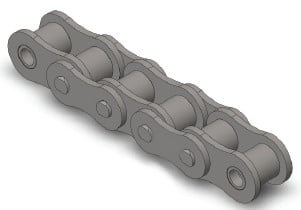Roller chains are a single on the most efficient and cost eff ective ways to transmit mechanical power between shafts. They operate in excess of a broad choice of speeds, deal with significant functioning loads, have pretty small energy losses and therefore are typically reasonably priced in contrast with other techniques
of transmitting power. Thriving choice involves following quite a few fairly straightforward steps involving algebraic calculation and the utilization of horsepower and services factor tables.
For just about any provided set of drive conditions, there are a variety of possible chain/sprocket confi gurations which will efficiently operate. The designer as a result should be aware of quite a few fundamental choice rules that when applied accurately, enable stability total drive effectiveness and cost. By following the methods outlined within this part designers should be ready to produce choices that meet the requirements on the drive and therefore are value eff ective.
Basic Roller Chain Drive Principles
? The advised quantity of teeth for your tiny sprocket is 15. The minimum is 9 teeth – smoother operation is obtained with more teeth.
? The recommended highest amount of teeth for that big sprocket is 120. Note that although a lot more teeth enables for smoother operation acquiring too lots of teeth prospects to chain jumping off the sprocket following a fairly modest amount of chain  elongation because of put on – That is definitely chains having a really big amount of teeth accommodate much less dress in in advance of the chain will no longer wrap close to them properly.
elongation because of put on – That is definitely chains having a really big amount of teeth accommodate much less dress in in advance of the chain will no longer wrap close to them properly.
? Speed ratios needs to be 7:1 or significantly less (optimum) and not higher
than 10:one. For greater ratios the use of several chain reductions is advised.
? The encouraged minimal wrap of your little sprocket is 120°.
? The advisable center distance concerning shafts is 30-50 pitches of chain. You will discover two exceptions to this as follows:
one. The center distance should be greater compared to the sum with the outside diameters of your driver and driven sprockets to avoid interference.
2. For velocity ratios higher than three:one the center distance shouldn’t be significantly less than the outside diameter in the large sprocket minus the outside diameter from the modest sprocket to assure a minimal 120° wrap all over the modest sprocket.